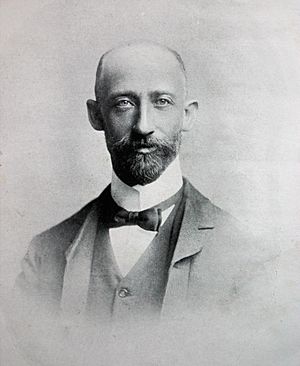Thomas Robertson Sim facts for kids
Thomas Robertson Sim was a very important botanist, someone who studies plants. He was also a bryologist, which means he specialized in mosses and liverworts. Born in Scotland on June 25, 1858, he later became a Conservator of Forests in Natal, South Africa. He is most famous for his huge book, The Forests and Forest Flora of the Colony of the Cape of Good Hope, published in 1907. Thomas Sim passed away on July 23, 1938, in Durban, South Africa.
Contents
Early Life and Learning
Thomas Sim went to school in Old Aberdeen until 1873. The next year, he received special lessons at Marischal College, part of the University of Aberdeen. In 1874, he started learning to be a gardener at the Royal Horticultural Society's gardens in England. This was his first step into the world of plants.
Training at Famous Gardens
In 1878, Thomas Sim got a job at the Royal Botanic Gardens at Kew, a very famous plant garden. Here, he learned a lot about botany from a well-known scientist, Sir Joseph Dalton Hooker. The next year, he worked for a year at the Harvard University botanic gardens in the United States. There, he was inspired by other great botanists like Asa Gray.
Returning to Scotland and South Africa
After his time in America, Thomas Sim returned to Scotland in 1881. He helped his father on their farm for several years. In 1889, he moved to South Africa and became the curator of the King William's Town botanical garden. This was a big step in his career.
Working to Protect Forests
In September 1894, Thomas Sim joined the Cape Forestry Department as a Government Forester. He started working at a place called Fort Cunynghame Plantation. He quickly showed how good he was at his job.
Promotions and New Roles
Within a few months, he was promoted to Superintendent of Plantations in the Eastern area. By 1898, he became a District Forest Officer, based in King William's Town. His hard work and knowledge helped him move up quickly in the forestry department.
Leading Natal's Forests
In 1902, Thomas Sim helped create a new forest department in Natal, another part of South Africa. The next year, in 1903, he became its very first Conservator of Forests. This meant he was in charge of protecting and managing all the forests in Natal. His main office was in Pietermaritzburg.
International Recognition
In 1907, he traveled to London to represent South Africa at an exhibition about its products. In 1908, he was asked to visit Portuguese East Africa (now Mozambique). He wrote a report about how to use the forests there. This report became a book called Forest Flora and Forest Resources of Portuguese East Africa, which included his own detailed drawings.
Later Life and Legacy
After his government work, Thomas Sim started a plant nursery in Pietermaritzburg in 1908. He also advised people on planting trees and growing forests on a large scale. He was involved in the timber industry and helped start the Wattle Growers' Association. He was also a founder of Cedara College of Agriculture.
Awards and Continued Work
Thomas Sim received many honors for his work. He was elected a Fellow of important societies like the Linnean Society and the Royal Horticultural Society. In 1919, he received an honorary D.Sc. degree from the University of South Africa. He also regularly wrote for the journal of the South African Association for the Advancement of Science.
Overcoming Challenges
In 1920, while at a meeting in Rhodesia, he had a stroke. This left him partly paralyzed, but he did not stop working. He gave up his business interests and spent all his time finishing his biggest project. This was a huge study of trees in Southern Africa, covering areas up to the Zambezi and Cunene Rivers. Sadly, he passed away before he could finish it. His unfinished manuscript and his library are now kept at the National Botanical Research Institute in Pretoria.
Remembering Thomas Sim
Thomas Robertson Sim is remembered in the name of a group of liverworts called Simia. Many plant names also include "Sim" to honor him. When you see the author abbreviation Sim next to a plant's scientific name, it means Thomas Robertson Sim was involved in describing that plant. It's important not to confuse him with James Taylor Robertson Sim, who was his nephew and also worked in forestry.
Sources
- Botanical Exploration of Southern Africa Mary Gunn & LE Codd (Balkema 1981)


